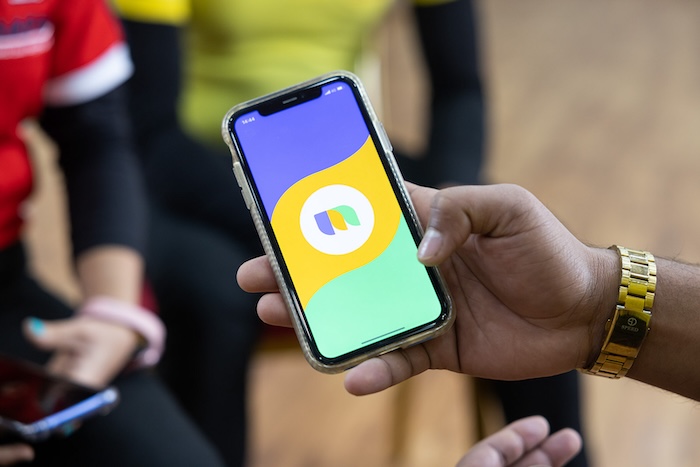The COVID-19 pandemic gave us insight into the challenges of traditional remittances. The restrictions imposed by the COVID-19 pandemic highlighted for many the challenges posed by traditional money transfer methods.
As Knomad, a migration and development firm, puts it, “mobility restrictions and limited public transportation make it difficult for people to reach branches and cash-in/out agents.”
In other words, the lockdowns meant it was unsafe (or even illegal) to travel down to exchange houses to send money to one’s family and friends, who were in urgent need of support.
Though the adoption of digital remittances was already underway before COVID-19, the pandemic accelerated it. According to the World Bank, “there was a greater use of digital remittance channels as hand carrying across international borders was disrupted by travel restrictions and lockdowns.”
Nevertheless, many people still don’t understand what a digital remittance is or why it should be preferred to the more traditional money transfer services, pandemic or not. In fact, according to the World Bank, digital remittances will only exceed traditional ones in 2024.
In this article, we will explain what a digital remittance is, how it differs from traditional remittance, and what benefits you can enjoy from embracing it. We’ll cover:
- What is a digital remittance: Introduction
- Digital remittance vs traditional remittance methods
- Benefits of digital remittances
- Getting the best out of digital remittances in the UAE
[Do you want to send money to your loved ones in a quick, cost-effective, and secure way? Inform your employer to register for our payroll software so you can gain access to our mobile bank account and send money to your loved ones abroad more efficiently.]
What is a digital remittance: Introduction
Basically, digital remittance refers to the electronic transfer of money from a person in one country to another person in a different country. The transfer can take place from one bank account to another, from one digital wallet to another, or from a digital wallet to a bank account; whatever the method, there is no physical transfer of cash.
The International Organisation for Migration defines it as “cross-border money transfers made over the internet by the migrant population to families in their home countries.” They also emphasise the connection between digital remittance (and digital payment in general) and mobile (and online) banking by noting that “digital remittances have evolved in parallel with mobile and online banking technology and many new operators have entered the marketplace and developed global businesses in digital and mobile commerce in response to the increasing demand.”
Though digital remittance ideally does not involve cash, there are situations where the recipient does not have a bank account or a digital wallet and the service provider has to provide cash pickup. However, this is an exception and mobile banking fintechs are working on initiatives to provide mobile banking for all.
Digital remittance providers vary by the electronic or digital channels they offer. Some allow users to send money via an internet or online portal, some have dedicated mobile apps, while others provide both.
Also, digital remittances are provided by a variety of companies. There are traditional banks that now provide digital payment solutions – which includes digital remittances as part of their internet or mobile banking features – specialised money transfer companies like Western Union and MoneyGram, and the relatively newer fintech companies.
According to Grand View Research, the market size of the global digital remittance market was $19.65 billion in 2022. They expect the industry to grow by 15.6% CAGR between 2023 and 2030.
Digital remittance vs traditional remittance methods
By traditional remittance methods, we refer to cross-border payments that involve the transfer and receipt of physical cash at given locations.
The most common facilitators of traditional remittancex are exchange houses. These are local financial institutions that help people send money to their family and friends abroad.
Sending money through an exchange house often involves travelling down to their physical location, standing in a queue, giving them cash in the local currency, and waiting for days for the transaction to be processed. On the other side, the recipient will have to travel to a physical location to retrieve the money that has been sent in their own local currency.
Commercial banks are also facilitators of traditional remittances. Here, we have in view bank-to-bank transfers that require the physical presence of the sender at the bank to initiate the transaction in contrast to the use of a bank’s online portal or mobile app. The latter option is still in its early form while the former option continues to remain dominant.
One difference between banks and exchange houses is that while exchange houses don’t require that the recipient has a bank account, traditional bank-to-bank transfers demand that both the sender and recipient have bank accounts.
Traditional wire transfer companies like Western Union and MoneyGram (two key players in the remittance industry) also provide traditional remittance services (in addition to their digital remittance services). Their service is similar to exchange houses – deposit of money in a physical location and retrieval of money in another physical location.
Differences between digital and traditional remittance
What are the major differences between a digital and a traditional remittance? Below are five:
- Cash usage: Traditional remittances require the physical movement of cash from the sender to the service provider and from the service provider to the recipient. With digital remittances, there is (ideally) no cash movement as transactions are done via bank accounts and digital wallets.
- Medium: Traditional remittances are initiated (by the sender) and concluded (when the recipient receives the money) at a physical branch of a bank, exchange house, or a wire transfer company. On the other hand, digital remittances are initiated and concluded on an online portal or via a mobile app. Even when there is a cash pickup, only the recipient will need to visit a physical location to collect cash.
- Access: Since traditional remittances involve physical cash and a visit to a physical location, they cannot be available 24/7. In contrast, digital remittances can be done at any time.
- Processing: The processing of traditional remittances often involves multiple partners at the point of sending and the point of receiving. This often leads to high cost and slow transaction speed. In contrast, digital remittances have fewer intermediaries, which makes transactions faster and less expensive (see below).
Now that we have seen how a digital remittance differs from the traditional one, let’s consider the benefits of digital remittances.
Benefits of digital remittances
Lower costs
As said above, the use of fewer intermediaries means that digital remittances are cheaper than traditional remittances.
A 2021 survey by the World Bank showed that sending $200 via mobile operators (that is, digital remittances) is cheaper (at a cost of 3%) than banks (10.4%), post offices (8.3%) and money transfer operators (5.2%). A 2021 report by The National also shows that using mobile money for remittances is cheaper (at 4.9% fees) than using a bank (7.11%), doing cash transfers (7.012%), or using credit or debit cards. And a study by Paypal and Xoom found that the cost of sending a digital remittance – 3.93% – is half of that of traditional remittances.
The lower fees charged by digital remittance providers is also the result of their low overhead. Unlike traditional providers, they don’t need to incur costs on various physical infrastructure.
Better exchange rate
Relatedly, the lower operational cost of digital remittance providers means they are also able to offer more competitive exchange rates for fund transfers.
Faster processing
Another advantage of having fewer intermediaries is that digital remittances can be completed more quickly compared to traditional remittances.
While a typical traditional remittance can take between 2 to 5 business days, many digital remittance providers can complete a large chunk of their transactions within 24 hours.
This fast processing speed means that migrants can meet the urgent needs of their family and friends without worrying about unnecessary delays.
Increased access
As said above, bank-to-bank transfers require that both sender and recipients have bank accounts. However, it is a known fact that there are millions of people across the globe without bank accounts. In 2017, the World Bank put the number at 1.7 billion people.
This problem is compounded by the difficulties migrant workers face when trying to open a bank account in the UAE. For example, banks require minimum account balances (AED 3,000 and above) that many of these workers cannot comply with. As a result, the unbanked population in the UAE has been estimated to be 32% by the Journal of Risk and Financial Management (this does not include the partially unbanked who make up 19% of the population).
Mobile banking fintechs like NOW Money are solving this problem by providing mobile bank accounts (mobile money accounts) from which migrant workers can send money abroad and enjoy other financial services. Also, the development of digital wallets across the globe has enabled international wallet-to-wallet transfers that don’t require traditional bank accounts at all.
Consequently, senders and receivers of remittances who don’t have bank accounts don’t have to be consigned to using more expensive options like exchange houses and wire transfer companies. Instead, they can enjoy both the greater access and lower remittance cost that digital remittance provides.
Convenience
Also, digital remittances can be conveniently concluded on a mobile smartphone unlike traditional remittances that will require a visit to a physical branch (and multiple visits when a problem occurs with the transaction).
The time saving that comes from this cannot be underestimated. According to the Paypal and Xoom study mentioned above, the average Mexican receiving digital remittance will save 15 days over a lifetime while the Mexican economy will save 100 million hours or $450 million in economic value.
Transaction tracking
Digital remittances platforms also provide real-time tracking of transactions on the mobile app or through the internet portal. Migrant workers don’t need to become anxious over the state of the transfer as they might be with a traditional remittance.
Security
But what about security? Aren’t traditional remittance service providers safer than digital ones?
Well, according to the World Bank, safety and transparency are part of the benefits of digital remittances. “We’ve seen that with digital solutions, transactions are now faster; more secure and transparent; offer more consumer choice; reach a far greater audience (through the use of mobile phones); and ultimately enable remittance providers to charge lower fees and offer enhanced services.“
Visa also agrees: “Digital remittances provide a reliable and secure way to send money home, bypassing the need to travel to a physical location to initiate a transfer.”
Digital remittances are safe because they ideally do not involve the use of physical cash. Also, most mobile apps provided by digital remittance service providers include various layers of security (2-factor authentication and biometrics, among others) designed to prevent fraudulent access to users’ accounts.
Getting the best out of digital remittances in the UAE
With expats representing more than 88% of UAE’s population, it is no surprise that the country is one of the top senders of international remittances. In fact, in 2020, it was the second-largest sender in the world.
It is therefore imperative that the vast number of migrant workers in the UAE have a quality and efficient remittance system that will meet their needs and that of their loved ones abroad.
NOW Money has provided such a system with its digital remittance service. Users of the NOW Money mobile banking app can send money to their family and friends abroad from the comfort of their homes or offices.
As a digital remittances provider, NOW Money offers competitive exchange rate and low (transparent) transaction fees.
NOW Money completes 99% of all its transfers within 24 hours, with bank transfers being finalised within just one hour. Every transaction can also be tracked on the app and users will receive notifications as the transaction progresses.
NOW Money also covers all the main corridors – Asia Pacific, Middle East, North Africa, Europe, North America, Latin America, etc. Wherever your family and friends live, NOW Money will get their money to them.
In addition, its experienced and expert customer service agents are available for calls and in-app chats between 9am and 9pm everyday. And users can choose to have the conversation in one of 11 different languages.
[Are you ready to let go of the inefficiencies of traditional money transfers and enjoy the benefits of digital remittances? Inform your employer to register for NOW Money’s smart and flexible payroll software so you can access our mobile bank accounts and send money to your loved ones digitally.]
Takeaways
- Digital remittances are the electronic transfer of money from migrant workers to their loved ones in another country.
- Digital remittances are done through bank accounts and digital wallets either through an online portal or a mobile app.
- Unlike traditional remittances, they don’t involve physical cash, a visit to a physical location, and multiple intermediaries. Also, digital remittances are accessible 24/7.
- Some of the benefits of digital remittances include: lower costs, better exchange rates, faster processing, increased access, convenience, transaction tracking, and security.







